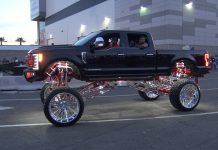VW literally could not give away its electric Golf ($46/month lease deals) mainly because the thing couldn’t go much farther than 80 miles on a charge – and that was “best case.”
Now comes the 2018 Honda Clarity, which will have a range of …. about 80 miles.
That figure puts the Honda well behind the Chevrolet Bolt’s advertised 238 mile range (your actual mileage will vary) and nearly every other battery-electric vehicle on the market. And it leaves Honda to tackle a tough problem: how to build a cutting-edge brand image around its Clarity line of electrified vehicles with an EV whose range barely tops that of a Nissan Leaf circa 2010.
The shortfall is not a failure of its engineering, Honda says, but the unavoidable result of its choices.
The automaker defined two parameters that were nonnegotiable: the physical size of the Clarity platform – which the EV shares with the Clarity plug-in hybrid and hydrogen fuel cell models – and the cost of the battery-electric version, which is expected to start around $35,000 before any tax credits or incentives.
With those hard points, Honda didn’t leave itself any leeway to fit a longer-range battery, which would have been heavier and costlier.
“A pillar of the Honda brand is affordability, and if Honda came out with some obscenely priced long-range electric car, what does that do for the brand?” Steve Center, vice president of environmental business development at American Honda Motor, told the trade publication Automotive News.
“Most of our customers would not be able to acquire it.”
Just how big a handicap the modest range figure will be remains to be seen. Thanks to regulatory pressures in California and other states, the number of electric and electrified vehicles on the market is expanding rapidly. While consumers haven’t gravitated to these vehicles in large numbers, those who do will soon be able to choose among many similarly priced options that offer varying combinations of size, range and brand cachet.
“To some degree, it’s all white space,” said Stephanie Brinley, senior analyst for IHS Markit, “and the market is going to spend the next several years figuring it out and where people want to buy in the spectrum of size and range. You just need to get it out there and see how people react.”











I don’t know what it is about these car makers. Are they afraid to lose their market share that they won’t stand up for what is right? Will people not buy reasonable cars?
Honda had a winning ticket with the first gen insight. The cars are amazing. The only down side is two seats. I’m sure they could find a way to add two more seats, especially kid sized. They get 65 mile per gallon!! So why don’t they sell them now? Why did they stop selling them to begin with?
I don’t understand the US market, people seem to not want cheap cars, is it because used cars are so good? Why won’t these car makers stand up to the epa and say enough is enough.
Hi Todd,
My bet is the Insight could not meet current federal crash standards; as far as the rest – it’s about financing and debt. People are able to “afford” cars they really can’t…
This is good though…. Just another sign of the system imploding. It won’t be long now. Businesses are destroying themselves; nations are destroying themselves (bringing in the worst scum immigrants); governments are destroying themselves (by making decrees that destroy the family, and which penalize productive functional people, while rewarding behaviors that result in dependency, disease and social dysfunction); Families are imploding (guy works hard to procide the best for his kids…sends kids to college where they are taught disfain for the very values which afforded them the privilege)….
It’s all going to come crashing down soon, ’cause it’s not just one or two segments of society, but rather everything at once.
Maybe we’ll get a brief taste of freedom when all of those who know nothing but dependence upon that system die off.
What a time to be alive though. To see the culmination of these things. It’s all breaking down, and there’s no way to fix it all. Even on a purely physical level: How do you replace all of the aging mega-dams which effectively now at end of life (most are much older than Oroville); the hundreds of thousands of bridges and tunnels?; The billions of miles of pipe and conduit?’ The millions of skyscrapers?, etc. etc.
When these things were built, no one seems to have given any thought to the fact that nothing lasts forever. They will need to be replaced. How does one replace the collective infrastructure which has been built over the course of 100 years? LOL- not enough money in the world! Maybe they should have thought these things out better. But instead, they are getting even crazier. They haven’t learned a thing- and now private businesses are imitating something that even government, with it’s ability to tax endlessly and create fiat money, can not sustain.
I think it should be obvious now: We are going to live to see this implosion. It is going to be very soon. Yay!!!!